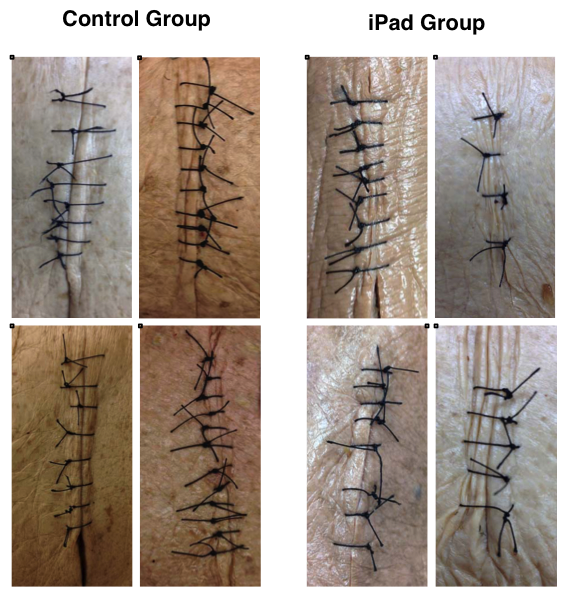iPads for Gross Anatomy Labs
Our project involved using iPads in the gross anatomy labs, specifically to teach students how to perform basic suturing techniques. In previous years, students would be taught suturing protocols via the much more faculty, time intensive function: an instructor would give a demonstration on how to suture with different techniques. Due to relatively small area of cadaver body being sutured, however, it would require the instructor to give this presentation in small groups of 3-5 students. It is not unusual for one faculty member to spend 20-30 hours per week teaching small student cohorts.
Tablet technology allowed us to prepare these demonstrations as short length videos that students can watch on their iPads. Students bring their tablets to the lab and use them in clear plastic bags to prevent them from being contaminated with any body parts or chemicals. They watch video clips showing how to hold the tools and how to perform different types of sutures. In this new format the instructor goes around and helps students with their techniques. Since he or she does not have to give multiple demonstrations, there is more time for one on one interaction with students and paying more attention to their individual techniques. They can pause and rewind the videos as they wish. Importantly, students are now able to review proper technique from the prepared videos, and to do so at their leisure. i.e., whenever they have free time and access to instruments.
In every group there are students with better or worse hand-eye coordination. Therefore, some students take longer than others to learn how to suture. While some students can repeat a suturing technique only after seeing it done once by the instructor, some students required multiple demonstrations. With the tablet technology, slow learners have the opportunity go back and watch the movie over and over, until they can conceptually understand every step of the suturing.
Unfortunately, several snow days prevented us from testing this technology on a larger number of students. We were able use it only on two sessions, where 4 students per session were in attendance. At each session, students were divided into two groups. One group had the iPad videos as their primary instruction; the other group had a faculty member as the instructor. They were both asked to perform simple interrupted sutures after the introduction. Students at the iPad group were allowed to go back and watch the instructions as many times as they needed.
At the end, pictures of sutures from both groups were taken to compare results. Students on the iPad group were asked to complete an online survey containing following 8 questions. First 6 are Likert Scale Questions (1-5) and the last two are open ended.
- I would recommend future students use the tablet technology used in learning suturing.
- The tablet technology used in this suturing session distracted me from the main content and/or activities.
- The use of tablet technology in this suturing session helped me get immediate feedback on my progress.
- Using the tablet technology helped me learn skills appropriate for this course.
- Using the tablet technologies was more convenient than other methods of content delivery used in learning how to suture.
- I frequently use tablet technology in my day-to-day life.
- Describe how the use of the mobile/tablet technology helped or limited your learning of the class content.
- Do you have any suggestions for other ways to use the mobile/tablet technology for learning class content?
Student feedback highlighted the benefit of watching the videos repeatedly for ease of learning. However, they still valued the instructor time and one-on-one teaching as the best method of leaning a specific hand skill. We presented our findings at a panel discussion at the 2014 TLISI (Teaching, Learning & Innovation Summer Institute). In order to evaluate the outcome of using iPads in suture lab, we took pictures of skin incisions on cadavers after students completed their procedures using simple interrupted sutures (Figure 1). We then compared quality of the work from two groups for incision closure, suture symmetry, distance between sutures, number of knots on each suture, and skin tension. We did not observe a significant difference between the control group and the iPad group. Therefore, we concluded that using iPads was as effective as an instructor for teaching basic suturing skills.

